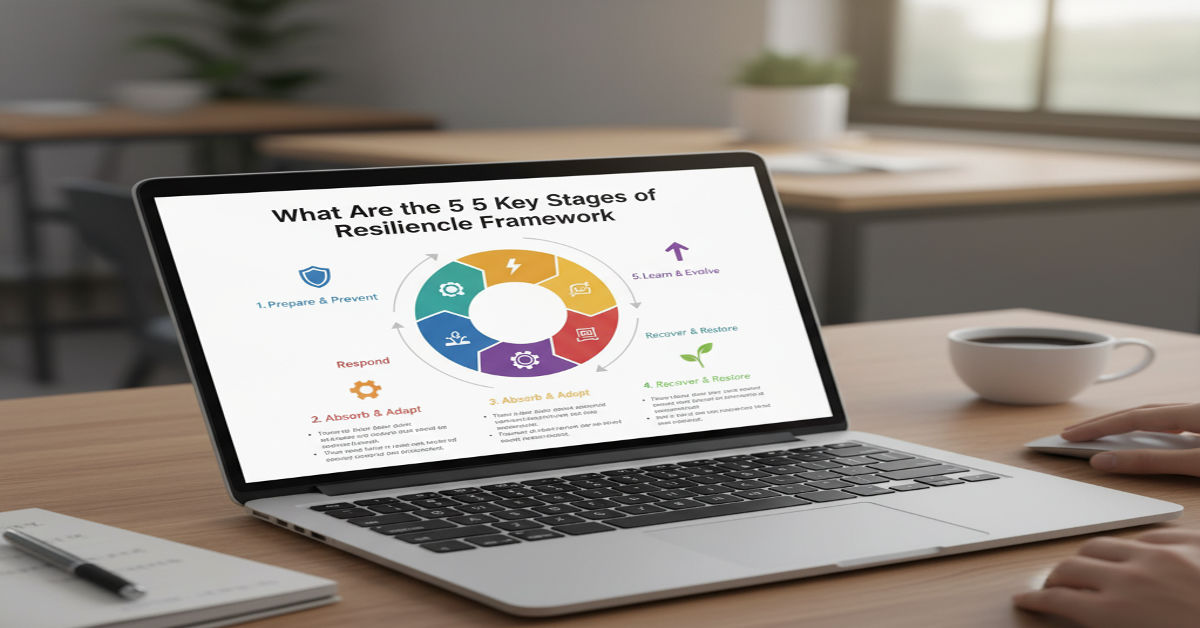Resilience has evolved from a personal virtue into a strategic necessity. In today’s unpredictable world, the ability to recover and thrive amid disruption separates successful organizations from those that falter. The resilience lifecycle framework provides a structured, evidence-based approach to building and sustaining that strength. It transforms uncertainty into opportunity by guiding individuals and organizations through five critical stages—anticipation, preparation, response, recovery and adaptation.
Each stage of the framework serves a unique purpose, but together they create a continuous cycle of improvement. From digital transformation to global crises, resilience is the secret behind longevity and adaptability. By applying these principles, leaders can not only protect their systems from shocks but use those experiences as catalysts for innovation and growth.
Understanding the Resilience Lifecycle Framework
The resilience lifecycle framework defines how systems prepare for, respond to, and evolve after disruption. It breaks resilience into five stages that together create a feedback loop of learning and adaptation. According to the World Economic Forum, resilience is no longer just a safety measure—it’s a performance metric that shapes competitiveness and sustainability.
This lifecycle approach emphasizes growth through experience. Every challenge becomes a lesson, and every recovery feeds future strength. By continuously refining this cycle, individuals and organizations can anticipate change with confidence and respond effectively, even in times of crisis.
Why the Resilience Lifecycle Matters Today
In a world defined by volatility, resilience determines survival. From geopolitical tensions to climate change, organizations must adapt faster than ever before. The Harvard Business Review notes that resilient leaders demonstrate agility, transparency, and emotional intelligence during uncertainty—qualities that foster trust and innovation.
As discussed in leadership resilience features, the lifecycle framework ensures that organizations move beyond short-term recovery and instead build lasting strength. By embedding resilience into strategy, businesses enhance credibility, maintain stakeholder confidence, and prepare for an unpredictable future.
The Foundation of Resilient Systems
A resilient system stands on three foundational elements: awareness, adaptability, and learning. Awareness enables early detection of emerging risks. Adaptability ensures flexibility under stress. Learning transforms experience into progress. Together, these create a living structure that grows stronger through disruption.
| Core Element | Purpose | Example in Practice |
| Awareness | Identify early warning signs | Monitoring market and supply chain data |
| Adaptability | Adjust strategies quickly | Reallocating resources under pressure |
| Learning | Integrate feedback into planning | Conducting post-crisis reviews |
These principles connect deeply to the five stages of resilience. They reinforce the idea that preparedness and adaptation are not separate acts but parts of one continuous cycle—a concept central to crisis management strategies.
Stage 1: Anticipation – Seeing the Storm Before It Arrives
Anticipation involves forecasting risks and recognizing opportunities before they arise. It relies on proactive monitoring, predictive analytics, and human insight. Organizations that excel at anticipation can identify weak signals early and prepare accordingly. The OECD emphasizes that anticipation enhances agility by aligning future scenarios with present decisions.
Beyond analysis, anticipation also cultivates imagination. Encouraging creativity and collaboration helps teams envision potential disruptions and explore innovative solutions. As highlighted in risk foresight and resilience, anticipation transforms uncertainty from a threat into a manageable opportunity for growth.
Stage 2: Preparation – Building Strong Foundations
Preparation transforms knowledge into readiness. Once potential risks are identified, organizations must act—creating plans, training teams, and allocating resources strategically. This stage ensures that systems remain functional even under extreme pressure. According to the United Nations Office for Disaster Risk Reduction, every dollar invested in preparedness saves up to six dollars in recovery costs.
Preparation also strengthens organizational culture. It builds confidence by equipping teams with the tools, roles, and mindsets they need during disruption. This phase is where structure meets spirit—where operational planning meets psychological resilience, as explored in organizational adaptability insights.
| Preparation Activity | Objective | Expected Benefit |
| Crisis simulation drills | Strengthen coordination | Quicker decision-making |
| Risk assessment workshops | Identify vulnerabilities | Focused mitigation plans |
| Resource mapping | Optimize asset use | Minimized downtime |
Effective preparation bridges anticipation and response, ensuring that every individual and system is ready when challenges emerge.
Stage 3: Response – Acting in the Face of Crisis
Response is the stage where plans become action. When disruption occurs, the ability to respond quickly and decisively determines the outcome. It involves activating emergency plans, coordinating communication, and prioritizing essential functions. The World Health Organization highlights that a well-structured response reduces damage and accelerates recovery.
Strong leadership is vital here. Transparent communication and empathy maintain trust and morale during chaos. As discussed in crisis-ready leadership, the response stage is a real-world test of resilience strategy—one that measures clarity, unity, and composure under pressure.
Stage 4: Recovery – Rebuilding Stronger Than Before
Recovery begins once immediate threats have been managed. It involves restoring operations, stabilizing finances, and rebuilding trust. Yet the best recovery strategies go beyond restoration—they use disruption as a catalyst for transformation. The Harvard Kennedy School suggests that post-crisis recovery should aim to “build back better,” embedding innovation and sustainability into renewal efforts.
Recovery is also an emotional process. It requires compassion, patience, and vision to rebuild motivation and collective purpose. As shared in organizational resilience renewal, true recovery is both practical and human—it balances rebuilding systems with reigniting hope.
| Recovery Area | Focus | Outcome |
| Operational systems | Restoring key functions | Stable performance |
| Workforce wellbeing | Supporting morale | Renewed confidence |
| Strategy evolution | Innovating through crisis | Stronger positioning |
Recovery sets the stage for adaptation, ensuring that lessons learned are embedded into future strategy.
Stage 5: Adaptation – Learning and Evolving from Experience
Adaptation is where resilience matures. This stage focuses on learning from past experiences and adjusting strategies accordingly. Adaptive organizations analyze data, review decision-making processes, and refine frameworks to reduce future risks. The McKinsey Global Institute identifies adaptability as one of the leading indicators of long-term organizational success.
Adaptation also nurtures creativity What Are the 5 Key Stages of Resilience Lifecycle Framework. By viewing failure as a learning opportunity, teams develop innovation mindsets. This approach not only strengthens resilience but fuels growth, ensuring that every disruption becomes a stepping stone toward transformation.
The Interconnection Between the Five Stages
Each stage of the resilience lifecycle framework connects to the next in a circular process. Anticipation informs preparation, preparation enables response, response facilitates recovery, and recovery inspires adaptation. Once adaptation occurs, the organization is better equipped to anticipate future challenges, completing the cycle of continuous evolution.
| Stage | Primary Role | Leads To |
| Anticipation | Identify emerging risks | Targeted preparation |
| Preparation | Establish readiness | Efficient response |
| Response | Manage crisis effectively | Structured recovery |
| Recovery | Rebuild and innovate | Adaptive learning |
| Adaptation | Integrate new insights | Enhanced anticipation |
This interconnection creates momentum—resilience becomes a dynamic capability that strengthens with every cycle.
Real-World Applications of the Resilience Lifecycle
The resilience lifecycle framework applies to nearly every field. Governments use it to manage climate resilience, healthcare systems apply it to pandemic response, and businesses rely on it for crisis management and supply chain continuity. The World Bank emphasizes that resilience frameworks are essential for sustainable development and risk governance.
In the private sector, adopting this framework gives organizations a competitive edge. As examined in resilience-driven innovation, companies that integrate resilience into strategy not only survive market disruptions but emerge as industry leaders.
How Organizations Can Implement the Framework
Implementing the resilience lifecycle begins with leadership commitment. Organizations must embed resilience into policies, training, and communication systems. The OECD recommends regular risk assessments and cross-functional collaboration to build adaptive capacity. Each department should understand its role in resilience management to ensure collective action.
Measurement is equally important. Setting clear indicators—such as response time, downtime reduction, and employee well-being—helps track resilience maturity. As detailed in strategic resilience planning, implementation works best when treated as an evolving process rather than a one-time initiative.
Challenges in Building Long-Term Resilience
Building resilience is challenging because it requires time, investment, and cultural transformation. Many organizations focus on short-term performance, neglecting the long-term systems that prevent future breakdowns. Leadership misalignment and lack of psychological safety can also hinder progress.
Overcoming these barriers means redefining resilience as a shared value. Encouraging transparency, collaboration, and ongoing learning helps organizations adapt to emerging threats. The World Economic Forum stresses that resilient institutions are those that balance risk awareness with innovation—constantly evolving to stay ahead of disruption.
Conclusion: Building a Future-Proof Mindset
Resilience is no longer optional—it’s a defining capability for the modern era. The five stages of the resilience lifecycle framework—anticipation, preparation, response, recovery, and adaptation—form a comprehensive path toward continuous improvement What Are the 5 Key Stages of Resilience Lifecycle Framework. By cycling through these stages, individuals and organizations evolve into stronger, more adaptable systems capable of thriving in uncertainty.
Embracing this lifecycle means adopting a mindset of learning, flexibility, and courage What Are the 5 Key Stages of Resilience Lifecycle Framework. As explored in future-ready leadership, those who treat resilience as a lifelong journey don’t just endure change—they shape it.
FAQs
1. What is the purpose of the resilience lifecycle framework?
It helps individuals and organizations strengthen their ability to anticipate, respond to, and recover from disruptions while continuously improving.
2. Why are there five stages in the framework?
Each stage addresses a unique aspect of resilience, ensuring a comprehensive and cyclical approach to growth and adaptation.
3. Can individuals apply this framework personally?
Yes, by anticipating challenges, preparing mentally, responding calmly, recovering thoughtfully, and adapting with intention.
4. How do organizations measure resilience success?
Through metrics like response time, recovery cost, employee adaptability, and sustainability improvements.
5. How does adaptation differ from recovery?
Recovery restores functionality, while adaptation evolves processes and mindsets to build future strength.







